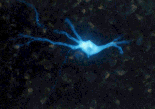| Sponsored by Wake Forest University School of Medicine and National Families in Action | |||
| Glossary - D | |||
| This glossary comes from False Messengers: How Addictive Drugs Change the Brain, by David Friedman, PhD, and Sue Rusche, Harwood Academic Publishers, Amsterdam, The Netherlands, 1999. A
| B | C
| D | E | F
| G | H
| I |
|
|||
| D Dalmane A depressant drug of the benzodiazepine family used to induce sleep. Decondition The unlearning of classically conditioned responses. Helping addicts identify and neutralize the cues or triggers they developed while they were addicted. Dendrites The branches that reach out from a neuron's cell body to receive messages from the axon terminals of other neurons. Denial Unconsciously refusing to admit that someone is addicted. Denial occurs among addicts themselves and among those who are close to them. Dentate gyrus A key part of the hippocampus that contains one of the highest concentrations of cannabinoid receptors in the brain. Deoxyribonucleic acid (DNA) The chemical compound that makes up genes. Depressants Drugs that relieve anxiety and produce sleep. Depressants include barbiturates, benzodiazepines, and alcohol. Designer drug An illegally manufactured chemical whose molecular structure is altered slightly from a parent compound to enhance specific effects. Examples include DMT, DMA, DOM, MDA and MDMA (ecstasy). Detoxification The process of removing a drug from the body. This is the initial period addicts must go through to become drug-free. Withdrawal symptoms appear early during this process. Depending on the drug, detoxification lasts for a few days to a week or more. Diversion Taking legally prescribed medications (e.g., methadone, tranquilizers) and selling them illegally. DMA A hallucinogenic "designer drug" with psychedelic properties.
|
|
DMT A hallucinogenic "designer drug" with psychedelic properties. DOM A hallucinogenic "designer drug" with psychedelic properties. Dopamine The neurotransmitter that produces feelings of pleasure when released by the brain reward system. Dopamine transporter A structure that straddles the cell membranes of axon terminals of dopamine-releasing neurons and rapidly removes dopamine from the synapse. Double-blind trials Studies of an experimental drug in which neither patient nor doctor knows whether the patient is receiving the experimental drug or some alternative (which might be a placebo if no treatment already exists). Dronabinol The generic name of synthetic THC. Drug addiction See Addiction. Drug-free treatment An approach to helping addicts recover from addiction without the use of medication. Drug treatment A combination of detoxification, psychosocial therapy and, if required, skill acquisition to help people recover from addiction. Dynorphins Peptides with opiate-like effects that are made by neurons and used as neurotransmitters; one of the endogenous opiods that binds to opiate receptors. |
|
| Home | For Journalists | For the States | Science Update | Links | Glossary | About |
Last Revision
info@addictionstudies.org

